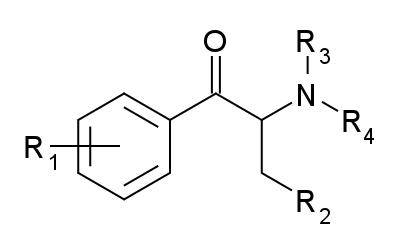The forensic world continues to grapple with the forensics of identifying synthetic drugs and their pharmacological and analytical chemistry characteristics. As we have written before just because there may be laws on the books or emergency or permanent regulations outlawing certain drugs and their analogues doesn’t mean that they can actually prove scientifically that the unknown substance that is seized and submitted for testing is actually the listed controlled substance and that the reported qualitative measurement (what is it?) is in fact specific (meaning it is that one substance and that one substance alone to the exclusion of every thing else). If the government cannot prove the validity of the qualitative measurement beyond a reasonable doubt, then there can be no conviction. Further in impaired driving prosecutions, if it cannot be proven that the drug actually exists in the blood because the analyst’s opinion as to the qualitative measurement is not valid, then there can be no conviction. Further, in the case of an impaired driving based prosecution, we do not have information that would allow a pharmacologist to opine impairment based upon an analytical chemistry result alone.
According to the United States Department of Justice- Drug Enforcement Administration- Office of Diversion Control:
Section 812 of the Controlled Substances Act (21 U.S.C. §801 et seq.) (CSA) lists substances which were controlled in 1970 when the law was enacted. Since then, approximately 160 substances have been added, removed, or transferred from one schedule to another. The current official list of controlled substances can be found in section 1308 of the most recent issue of Title 21 Code of Federal Regulations (CFR) Part 1300 to end (21 CFR §1308) and the final rules which were published in the Federal Register subsequent to the issuance of the CFR.
This list describes the basic or parent chemical and do not describe the salts, isomers and salts of isomers, esters, ethers and derivatives which may be controlled substances. These lists are intended as general references and are not comprehensive listings of all controlled substances. Please note that a substance need not be listed as a controlled substance to be treated as a Schedule I substance for criminal prosecution. A controlled substance analogue is a substance which is intended for human consumption and is structurally or pharmacologically substantially similar to or is represented as being similar to a Schedule I or Schedule II substance and is not an approved medication in the United States. (See 21 U.S.C. §802(32)(A) for the definition of a controlled substance analogue and 21 U.S.C. §813 for the schedule.)
We have blogged on it before with these posts:
- Can (insert analyte) be tested for by GC-FID or GC-MS?
- DEA Moves to Emergency Control Synthetic Stimulants
- New Designer Drugs Pose a Problem for Forensic Science
- Pennsylvania Bans Bath Salts and Synthetic Marijuana
- Bath Salt Laws in PA
- PA DUI Drugs Update: K2 Banned by DEA
- Dear PA DUI Attorney: Can You Land a DUI for Synthetic Marijuana?
With this post, I would like to focus mostly on synthetic cathinones. Cathinones can naturally occur. The plant is otherwise known as Khat (“jaad” or “qaat” in Somalia, “chat” in Ethiopia, and “qat” or “gat” in Yemen). Khat is a naturally occurring plant that is prevalent in eastern Africa and regions in the Middle East. Khat as a plant is typically chewed by the user to produce the stimulant like effect.

By this time, most people have heard of the most popular of these synthetic cathinones by their street name “Bath Salts” which is technically called 3,4-Methylenedioxypyrovalerone or MDPV. Other popular synthetic cathinones include methylone and mephedrone (para-methoxymethcathinone, 4-methoxymethcathinone, bk-PMMA, PMMC, and methoxyphedrine). Other street names for these types of drugs include: plant food, insect repellant, vanilla sky, cloud nine, lunar wave, red dove, blue silk, blizzard, ice crystals, and snow leopard.

Emerging out of Europe and out of makeshift and even sophisticated laboratories mainly in China includes the following that are similar in nature:
- α-pyrrolidinopropiophenone (α-PPP or a-PvP).
- 4′-methyl-α-pyrrolidinopropiophenone(MPPP)
- 3′,4′-methylenedioxy-α-pyrrolidinopropiophenone(MDPPP)
- Derivatives of pyrovalerone such as Naphyrone (naphthylpyrovalerone and O-2482), otherwise known as Cosmic Blast or Jewelry cleaner
- Mephedrone (4-MMC or 4-methylmethcathinone or 4-methylephedrone), otherwise known as MCAT
- 4-Methylethcathinone (4-MEC)
-
Pentylone (a-Keto-Methylbenzodioxolylpentanamine) which is not a synthetic cathinone but is often blended with synthetic cathinones (NRG-1, NRG-2 and now NRG-3)
- Butylone, which is not a synthetic cathinone and is also known as β-keto-N-methylbenzodioxolylpropylamine (bk-MBDB), is anentactogen, psychedelic, and stimulant of the phenethylamine chemical class. It is the β-ketoanalogue of MBDB.
The scope of the issue is quite large. Here are the possible ring substitutions for cathinones.

The derivatives may be produced by substitutions at four locations of the cathinone molecule:
- R1 = hydrogen, or any combination of one or more alkyl, alkoxy, alkylenedioxy, haloalkyl or halide substituents
- R2 = hydrogen or any alkyl group
- R3 = hydrogen, any alkyl group, or incorporation in a cyclic structure
- R4 = hydrogen, any alkyl group, or incorporation in a cyclic structure
The following table displays notable derivatives that have been reported:
| Compound | R1 | R2 | R3 | R4 |
|---|---|---|---|---|
| Cathinone | H | H | H | H |
| Methcathinone | H | H | H | Me |
| Ethcathinone | H | H | H | Et |
| Buphedrone | H | Me | H | Me |
| NEB | H | Me | H | Et |
| NEP | H | Et | H | Et |
| Pentedrone | H | Et | H | Me |
| Dimethylcathinone | H | H | Me | Me |
| Diethylpropion | H | H | Et | Et |
| Bupropion | 3-Cl | H | H | t-Bu |
| Mephedrone | 4-Me | H | H | Me |
| 3-MMC | 3-Me | H | H | Me |
| 4-EMC | 4-Et | H | H | Me |
| 4-EEC | 4-Et | H | H | Et |
| Benzedrone | 4-Me | H | H | Bn |
| 4-MEC | 4-Me | H | H | Et |
| N,N-DMMC | 4-Me | H | Me | Me |
| N,N-DEMC | 4-Me | H | Et | Et |
| 3,4-DMMC | 3,4-dimethyl | H | H | Me |
| Methedrone | 4-MeO | H | H | Me |
| Ethedrone | 4-MeO | H | H | Et |
| 2-FMC | 2-F | H | H | Me |
| 3-FMC | 3-F | H | H | Me |
| 3-CMC | 3-Cl | H | H | Me |
| Flephedrone | 4-F | H | H | Me |
| Brephedrone | 4-Br | H | H | Me |
| FMMC | 3-F-4-Me | H | H | Me |
| bk-MDA | 3,4-methylenedioxy | H | H | H |
| Methylone | 3,4-methylenedioxy | H | H | Me |
| Ethylone | 3,4-methylenedioxy | H | H | Et |
| BMDP | 3,4-methylenedioxy | H | H | Bn |
| bk-IMP | 3,4-trimethylene | H | H | Me |
| 4-Fluorobuphedrone | 4-F | Me | H | Me |
| 4-MeMABP | 4-Me | Me | H | Me |
| 4-Methoxybuphedrone | 4-MeO | Me | H | Me |
| Butylone | 3,4-methylenedioxy | Me | H | Me |
| Eutylone | 3,4-methylenedioxy | Me | H | Et |
| BMDB | 3,4-methylenedioxy | Me | H | Bn |
| bk-DMBDB | 3,4-methylenedioxy | Me | Me | Me |
| 5-Methylmethylone | 3,4-methylenedioxy-5-Me | H | H | Me |
| 2-Methylbutylone | 2-Me-3,4-methylenedioxy | Me | H | Me |
| 5-Methylbutylone | 3,4-methylenedioxy-5-Me | Me | H | Me |
| Pentylone | 3,4-methylenedioxy | Et | H | Me |
| MEP | 4-Me | Et | H | Et |
| bk-Methiopropamine | thiophen-2-yl instead of phenyl | H | H | methyl |
| α-Phthalimidopropiophenone | H | H | phthalimido | |
| α-PPP | H | H | pyrrolidinyl | |
| α-PBP | H | Me | pyrrolidinyl | |
| EPBP | 4-Et | Me | pyrrolidinyl | |
| MOPBP | 4-MeO | Me | pyrrolidinyl | |
| O-2384 | 3,4-dichloro | Me | pyrrolidinyl | |
| α-PVP (O-2387) | H | Et | pyrrolidinyl | |
| MPPP | 4-Me | H | pyrrolidinyl | |
| MOPPP | 4-MeO | H | pyrrolidinyl | |
| MPBP | 4-Me | Me | pyrrolidinyl | |
| Pyrovalerone (O-2371) | 4-Me | Et | pyrrolidinyl | |
| MPHP | 4-Me | Pr | pyrrolidinyl | |
| MDPPP | 3,4-methylenedioxy | H | pyrrolidinyl | |
| MDPBP | 3,4-methylenedioxy | Me | pyrrolidinyl | |
| MDPV | 3,4-methylenedioxy | Et | pyrrolidinyl | |
| O-2390 | 3,4-dichloro | Et | pyrrolidinyl | |
| O-2494 | 4-Me | iPr | pyrrolidinyl | |
| Naphyrone (O-2482) | β-naphthyl instead of phenyl | Et | pyrrolidinyl | |
| α-PVT | thiophen-2-yl instead of phenyl | Et | pyrrolidinyl | |

Very little is known about the pharmacology of these substances in terms of the pharamcokinetics (the absorption, distribution, metabolizing, and elimination) or the pharamcodynamics (the psychomotor and physical effects) of these drugs as there are no meaningful controlled studies involving these drugs. Purely anecdotal reports include increased heartbeat and sweating. The effects are reported to be similar to that of stimulants, MDMA and methamphetamine. However, there are no controlled studies that give definitive guidance as to what the expected affect is. Further unknown is at what result in terms of the analytical chemistry will cause impairment and what affect chronic dosage and usage will have. What little research there has been has been wholly inconclusive Dr. Adam Winstock, of Kings College, London, Department of Addictions has published a few studies, but they need to be further scrutinized and repeated.
The jury is still out.



Cynthia Slagle says:
Good post. There is so much meat here that gets get my attention and will cause me to share it with others. I own a Drug and Alcohol Testing facility and it’s important for me to see what others insights are with relation to synthetic drugs to see how what I do fits in with that. Thanks- I bookmarked your blog and I’ll be back to see what else you post that I can learn from.
Jerome Tierney says:
I have a case right now where my client was arrested for possessing 1000 grams of what turns out to be 4-methylethcathinone. The drug was first opened by a Homeland security agent at the local post office. Eventually my client picked it up and was then arrested. I don’t believe that it’s illegal in Pennsylvania. However, the state trooper has indicated that he will pursue the case as a designer or look-alike for mephedrone, i.e.,
(4-methylmethcathinone). The trooper indicated that the feds would prosecute my client if he wasn’t prosecuted at the state level. Dilemma!
Jerome L. Tierney, Esquire
724-864-7757